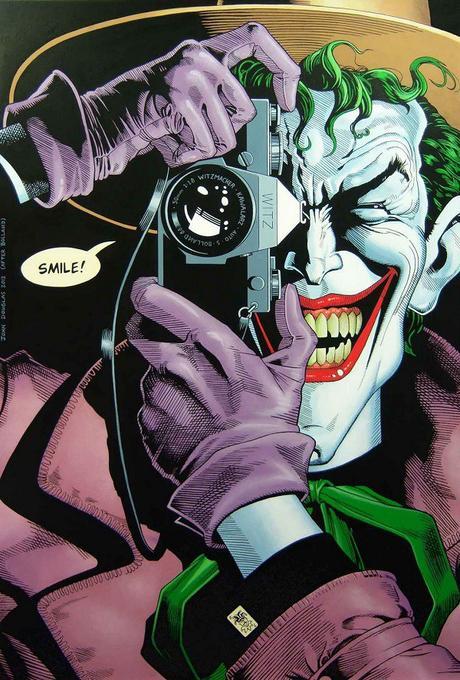
The Killing Joke is probably one of the more equally famous and controversial Batman comics. Written by Alan Moore and drawn by Brian Bolland in 1988. It is called one of the most important Joker stories and has been given as reference material for the Batman movies by Tim Burton, Christopher Nolan, and the current films with Jared Leto. So is it a great story worthy of that importance and is its legacy worth it? Time to explore that.
The book starts off with the Batman visiting the Joker in Arkham Asylum, he’s come to talk as he has realised that the path the two are currently on will lead to one of them killing the other or both of them dying, and he wants prevent that. He tries to open a dialog but he soon realises he’s not talking to the Joker but an imposter the Joker has placed there so he can be free to run around town without Batman noticing. He’s busy buying a dilapidated old amusement park, by killing the owner and having his goons strong arm his partners into signing it over. The Joker then kidnaps Commissioner Gordon and shoots his daughter, and former Batgirl, Barbara. He then undresses her to take nude photographs of her. Gordon wakes up naked in the amusement park where Joker tries to drive him mad, including using the naked pictures of his daughter, to prove anyone can become like him if they have one bad day. Batman tracks Joker down and frees Gordon, who has not been broken by the Joker’s attempts, and he tells Batman to bring Joker in by the book to prove the they’re better than him. Batman confronts Joker and tells him he’s realised if they keep on going like this one of them will kill the other, offering to help him become sane again. Joker tells Batman he realised that a long time ago, and then he tells a joke similar to their situation, then Batman and the Joker laugh as police cars pull up. Interspersed with this story is another one, telling the origin of the Joker in the days before he donned the Red Hood and fell into a vat of chemicals.
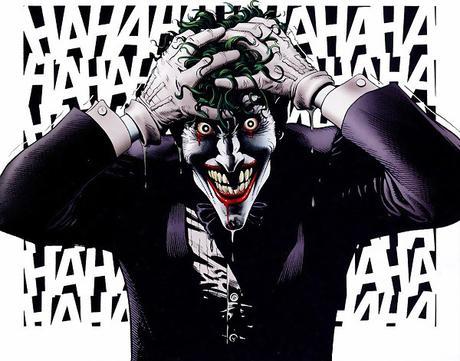
The Origin
One of the big things this graphic novel did was provide an origin for the Joker by putting together the scattered pieces of Joker mythology that had been around since his creation. To this day he still doesn’t have one definitive origin but many. The key points are always the Joker being a crook called the Red Hood, who in a fight with Batman fell or jumped into a vat of chemicals forever bleaching his skin white and making him insane. The details between those change sometimes, whether he was a mastermind crook or a washed up comedian in over his head, if he’s really insane or just putting on a brilliant act because he’s just that clever, but the Red Hood, Batman, and the vat of chemicals, remain the same.
What the Killing Joke did to the origin was to make the Joker’s previous life tragic and sympathetic. He tried to fulfill his dream of being a comedian instead of working at a chemical plant all his life, but with his wife pregnant and his dream career turning into a dud he’s offered a chance to make some quick money by some mobsters. It was just to lead them through the old factory he used to work at so they can rob the place next door, to conceal his identity they offer up the Red Hood mask. Unbeknownst to him the Red Hood is just a patsy for the gang so they can point to him and claim he’s the leader of the gang if things go wrong. The day of the heist the comedian gets the bad news that his wife and unborn child have been killed in a freak accident. He tries to back out of the heist but the mob guys strong arm him to go through with it. The heist goes badly, with them getting spotted by a guard the comedian didn’t know about and one of the mobsters is killed and the other injured, who then points to the Red Hood as the man they want to shoot. Batman then shows up, thinking it’s the same Red Hood he’s faced before. The comedian freaks out and tries to get away by jumping into a vat of chemicals and swims to safety, but when he gets outside his skin has been bleached white, his hair green, and his mind snapped.
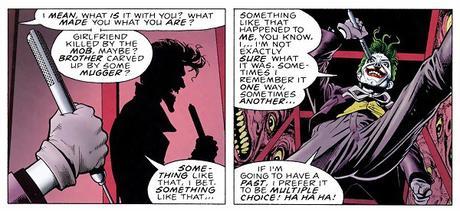
The Joker later says he can’t remember his origin, stating “sometimes I remember it one way, sometimes another. If I’m going to have a past, I prefer it to be multiple choice.” Some have taken that line to mean the origin is not canon, or at least incredibly unreliable, but that doesn’t quite fit with how the book portrays it. The origin story is not presented as multiple interpretations of the same event, there is no changes or deviations, just one single story told as a flashback. If it was intended to be just one of the Joker’s multiple choice backstories then it is terribly done, as it could’ve weaved together lots of subtle differences as the story went on, change what characters look like and small details like the names of places and people, anything to suggest that the story itself is unreliable. But the story doesn’t do any of that. What I think the story does suggest is that the details of the Joker’s backstory doesn’t matter to him as a character. As he speculates on the trauma that made Batman put on the cape and punch bad guys he says “Something like that happened to me, you know. I… I’m not exactly sure what it was.” then says the multiple choice line. That suggests that the Joker himself doesn’t know what happened rather than the origin story being false, and also that the tragic sympathetic backstory doesn’t matter because in the end he doesn’t actually care about it and doesn’t even remember it. The “multiple choice” idea was referenced and made much better in the Mad Love comic and the Dark Knight movie, both actually had the Joker telling multiple versions of the same childhood trauma instead of just one story and then having him say it was “multiple choice.”
I don’t think the Joker’s backstory matters too much beyond Batman causing him to fall into the vat of chemicals, the one in this story is serviceable enough. It doesn’t try to paint his life as something other than a normal crappy life, there’s no over the top childhood trauma to justify his actions, no abuse, nothing that is usually done for psychopathic characters like him. There are hints that he’s got a bit more going on under the surface, in order to show Batman’s point that maybe the Joker was always crazy and his “one bad day” stuff is him trying to justify the events to himself. If no one else snaps after one bad day like he did then that’d mean he was lying to himself, which is why he tires so hard to prove that it’s true in this story, and then ultimately fails. An origin for the Joker is just an attempt to justify why he’s a murdering psychopath, which isn’t a particularly interesting or needed story. Moore’s take on him being a regular guy who was just down on his luck works just because it doesn’t try to make the Joker out to be anything special before he became the Joker.
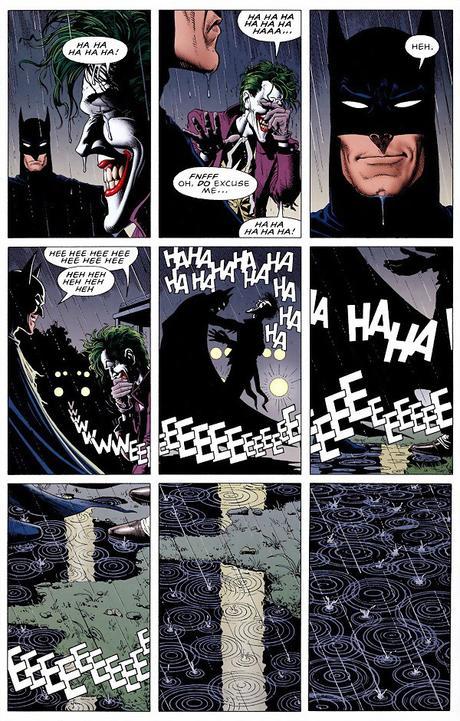
Did it kill the Joker?
This is not a new theory but one that got some larger traction when Grant Morrison brought it up again in 2013, that at the end Batman killed the Joker. It is a rather simple idea, based on the final page where the Joker and Batman are laughing together and we see Batman grabbing the Joker as the panels move to show than ground and the rain as the laughter slowly fades away. Add that to the opening where Batman is saying how one day they are going to kill each other and he hopes to stop that, that’s a good reading of how it ends with one of them dying. The fact that supposedly Alan Moore has said he didn’t want the story to be canon lends credence to the theory, since the only lasting part of continuity from the story was Barbara getting crippled and that doesn’t seem likely to be something Moore cares about since she was just a prop to hurt Batman and Gordon in this. But if he wanted Batman to kill the Joker then that would be something that sparks the canon question. Now it is just an interpretation of the story , where you can just read the book and never think about the ending as anything but the Joker getting arrested and the cycle of Batman/Joker stories continue.
There are those that dispute this reading, some citing the original script as some sort of original authors intent despite the fact that it doesn’t confirm it one way or the other. The script neither says he kills the Joker or that the Joker is definitely alive at the end. Those citing the script just point out symbolism or a bit of wording by Moore potentially suggesting the Joker’s still alive, Moore being famous for his overly wordy scripts. Author intent is one thing, but once a piece of work is out there for the public to see they can interpret it in many different ways, regardless of what the intentions were when making it.
Regardless of original intent I think the story works better if Batman kills him. The story sets up some very horrible things the Joker has done, and in the end Batman snaps and laughs at the Joker as he kills him. We see the Joker’s beginning and then his end, while setting up the question at the start for how long the two can keep going before one kills the other. That question is brought up continually and at the end the Joker clearly says he won’t stop, he can’t accept Batman’s help, and he’d be crazy to do so. The joke at the end being a metaphor for both of them being crazy and trying to escape it, and while Batman might be able to the Joker can’t make that jump. Batman’s offer of help is intangible and would only lead to the Joker’s death, and the Joker just doesn’t think Batman will go through with helping him anyway. So with Batman’s help denied and him actively discussing the inevitability that one of them will kill the other at some point unless they stop fighting the ending scenario where Batman decides to end the Joker’s life isn’t so implausible. Even with his “no killing” code he still says at the start one day he will kill the Joker, so it’s something he’s considered and thinks is inevitable.
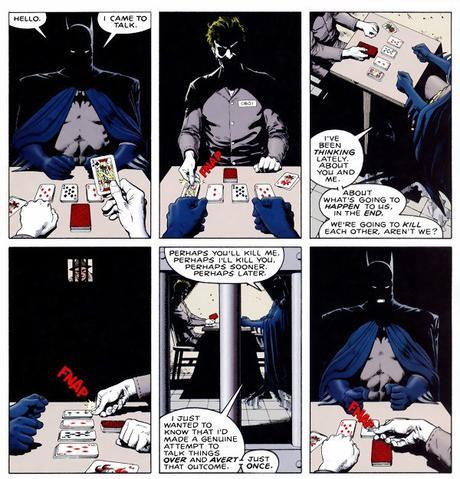
I’ve never been a fan of the “Should Batman kill the Joker?” question/debate because it sets him up as having the moral right to execute the Joker and saying that ultimately the Joker is his responsibility, along with a whole host of ideas about Batman’s morality. I don’t think he has a responsibility to kill him, I do think it’s a little stupid the Joker hasn’t been killed by the Gotham PD in any of the times they’ve had to transport him after arresting him, no one’s thought about shooting him and faking an escape attempt since he’s probably hurt/killed a lot of police officers. But here, in this story with its set up of “we’re going to eventually kill each other,” I can see it happening. It’s not about the morality of it but the inevitability of it happening.
There’s another train of thought that Moore has set up a commentary on the meta-narrative of Batman and Joker’s relationship. DC Comics will keep making Batman and Joker stories, Joker does something bad, they will fight, neither will kill the other, and the cycle will continue unbroken because DC wants to keep making Batman/Joker stories. That’s why the story ends not with a “the end” caption, but rain on the ground causing circular ripples in water that mirror the opening panels. It’s a good theory, and possibly what Moore intended, but I don’t think the rest of the book holds up with that theory. The Joker’s origin doesn’t fit with the circular meta-narrative, nor does his plan. In fact while the origin gives us Joker’s “one bad day can make you snap and become like me” motivation for his attack on the Gordons, it breaks that cycle. Barbara survives unlike the Joker’s wife, Jim Gordon doesn’t snap like the Joker did, so if the story is about the circular nature of things it does fail to provide it beyond the opening and ending scenes. Moore has said he doesn’t consider Killing Joke to be “very good,” so maybe the meta commentary not being as well put together as it could’ve been is part of the reason why he doesn’t like it.
However if the story was about Batman killing the Joker, breaking the cycle they realize they’re on, then Gordon not falling into Joker’s insanity fits with that theme. Showing that just because something has happened before doesn’t mean it has to happen again, that just like one really bad day doesn’t have to make you the Joker then figuring out that you’re on an endless cycle of fighting the Joker doesn’t mean you can’t break that cycle. I do think Moore probably didn’t intend for the ending to imply Batman kills the Joker, a meta-narrative about being stuck in an unbreakable mass market fiction cycle fits with his style.
The thing is we’re allowed to have multiple readings of texts, critical analysis is about what the analyser gets from the text. Which will vary from person to person since not everyone has the same perspective and experiences that effects what they get out of a given piece of work. Stories can have multiple interpretations just like any piece of art, and this comic is no different.
And given the readings of the last few pages are “Batman laughs with the Joker after he crippled and sexually assaulted one of his friends and tried to drive another insane, having accepted his and the Joker’s circular narrative” or “Batman gives the Joker a chance to change or they’d both end up Killing each other, Joker says no and Batman laughs before he strangles the Joker since there’s no hope in changing things.” I think the latter is better. Even if you don’t care about meta-narratives or deep readings into themes and consider Batman killing the Joker to be out of character therefore it couldn’t happen, I’d still say it’s more in character than him laughing with the Joker. Batman laughing shouldn’t be an odd thing, the character being a stoic loner with no sense of humor is less interesting the more he’s portrayed that way, but laughing with the Joker is not in character in any version of Batman I know of. Especially the story that was meant to push the boundaries of how much of a villain the Joker was, this wasn’t a 60s comic where the Joker tried to steal a giant musical instrument but a story where he crippled one of Batman’s allies and psychologically tortured another one. Their relationship was better depicted in Frank Miller’s Dark Knight Returns when Batman spits on the Joker’s corpse rather than having any inner monolog over him being a “worthy adversary” or some such.
Batman’s not been shown as particularly bothered at potentially killing the Joker at times either. Sure there have been stories where he’s actively saved Joker’s life, but take these panels from Mad Love where they’re on top of a speeding train and he punches the Joker. Now he’s aware he’s on a train and that punching someone with enough force will cause them to fall off the train and die, but it doesn’t seem to bother Batman.
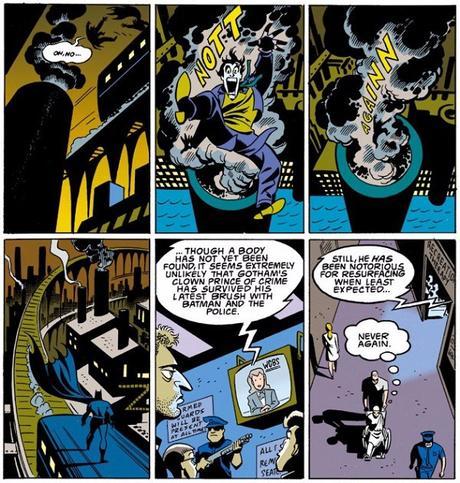
Now the Joker survives because that’s what he does. It’s a cliché at this point for him to seemingly “die” at the end of a story but no one finds a body so everyone assumes he’s going to show up again. But if Batman really doesn’t mind the Joker dying, by his hand or another’s, and has actively considered that they’re going to kill each other then him killing the Joker isn’t that far fetched. Now as I’ve said I don’t actually like the idea that it’s Batman’s responsibility to kill the Joker like some fans suggest, and I do prefer moments like Batman’s speech at the end of the Under the Red Hood movie to things like that, but in this story it works. Continuity be dammed the story structure works so much better if at the end the Joker dies by Batman’s hand, there’s been many Batman stories that haven’t been canon so this one can be too. There’s only really one part of it that people keep using that could make it canon.
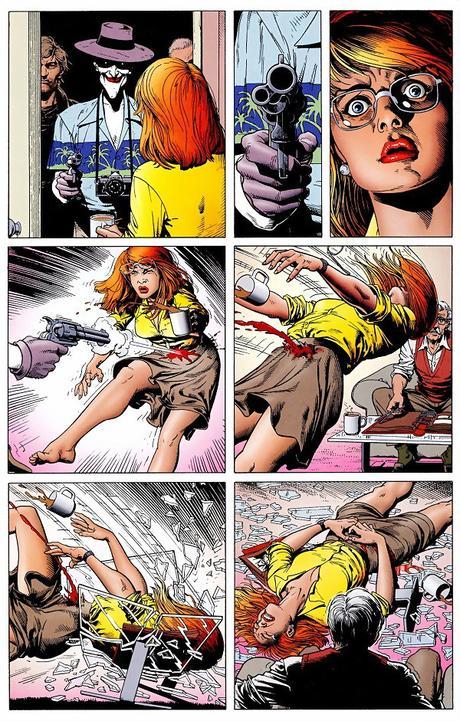
The tragedy of Barbara Gordon
The big thing that caused outrage was the crippling of former Batgirl Barbara Gordon and her sexual assault by the Joker. He knocks on her door, she opens it and gets shot by him, he then kidnaps her father Commissioner James Gordon, the Joker then strips Barbara naked and takes pictures of her (whether or not he raped her as well is still an ongoing fan debate, though I don’t believe that he did), and all of this is to try and drive James Gordon mad. Fans of Barbara have been rightly upset by this story because of how it treats the character, while some don’t seem to understand exactly why it’s such a problem. I think that’s due to it being a 30 year old story, we get to see what happened after the story and Barbara’s journey, which ties back into why this story is terrible to the character of Barbara Gordon. She has no agency, she has no narrative in this, she is just used as a prop to hurt Batman and James Gordon. This isn’t a story about her being crippled and over coming it, this is a story about the Joker trying to drive James Gordon mad and crippling and sexually assaulting his daughter is just another tool to do it. And it is sexual assault regardless of whether or not he raped her, because being forcibly stripped naked and photographed is under the definition of sexual assault.
This situation is different than the other stories of tragedy that have happened to Bat-family members, Jason Todd gets beaten to death by the Joker in a story where Jason is the main focus and trying to reunite with his long lost mother. Batman himself gets crippled in Knightfall and it is a story all about him and the mantle of Batman. The Killing Joke isn’t about Batgirl or Barbara, she’s just a side note, a story reason to hurt Batman and James Gordon, nothing more. If you remove Barbara from this story entirely the plot still functions the same way, everything can still happen without her being there, the only thing it affects is the level of pathos and the angst. It’s debatable whether or not the story would work as well as it does, but there’d still be a story there unlike Knightfall or Death in the Family if you remove Batman or Jason.
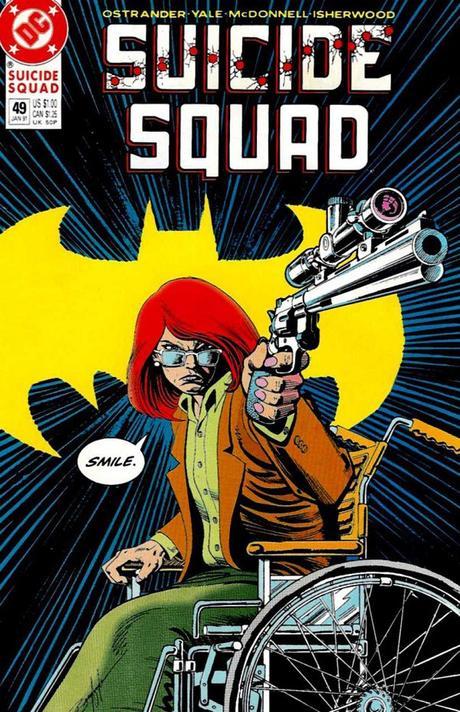
After this comic John Ostrander and Kim Yale had a story idea for the crippled Barbara Gordon. She would be a hacker and computer expert in Ostrander’s Suicide Squad comic with the codename Oracle, and in turn became incredibly popular. Eventually getting her own team book with Birds of Prey and through appearances in Justice League becoming the top information broker in the DC universe, essentially being one of the most valuable character to every DC hero. More than that she became an icon for disabled fans, showing that even though she’s in a wheelchair she can still be the hero, she can be so great at her job at Batman relies on her and not the other way around. She’s strong, she’s capable, and one of the best things DC ever did from 1988 to 2011.
John Ostrander also co-wrote a story with Kim Yale for Batman Chronicles issue 5 called Oracle Year One, about Barbara’s life after the Killing Joke and how she became Oracle. It’s a great character piece and any Babs fan who hasn’t read it yet should definitely check it out. It does more than just make her Oracle, it also provides commentary on the Killing Joke and even uses its plot holes to do so. When Batman comes to see her the night before she’s discharged from the hospital Barbara mentions she would’ve died if the Joker had been using a regular bullet rather than a doctored one, because the Joker wanted her alive since that’d torture Batman more. She talks about how her life had no importance except for her connection to him, an obvious comment on how poorly she was handled in the Killing Joke.
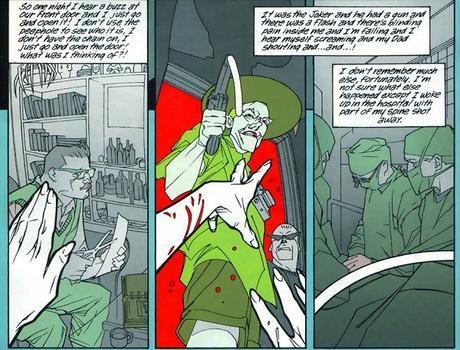
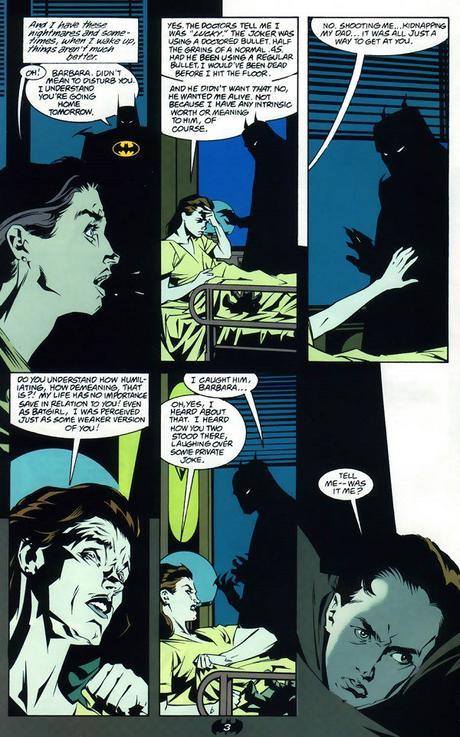
The integrity of the character didn’t matter as much as how she could be used to hurt Batman. Then she hurls the big one at him, saying she heard how he and the Joker stood laughing together, and Batman has no response to that, because there isn’t one. This is a story about fixing the character as much as it is about Barbara fixing herself. Ostrander and Yale managed to do more for the character of Barbara Gordon in one single page of this 18 page story than Moore did in 45 pages of the Killing Joke. Writers like Ostrander, Chuck Dixon, Gail Simone, and Grant Morrison took the horrible mess that had been left from The Killing Joke and forged a great character and kept improving her. She was an inspiration, an incredible feat of comics ingenuity and creativeness, so naturally DC editorial got rid of Oracle in 2011 and wanted to pretend like she was never Oracle at all.
In 2011 DC rebooted their comics universe and Barbara Gordon was back as Batgirl due to editorial wanting to bring back their childhoods, the same thing caused Hal Jordan and Barry Allen to come back to life despite the stories of Green Lantern and Flash having improved greatly because they died. So Barbara was back as Batgirl, having her broken spine repaired off panel because writer Gail Simone wanted to actually keep her time in a wheelchair and as Oracle intact and not be swept away. Editorial did not want any references to Oracle though, but of course wanted to milk Killing Joker references. DC will keep on pushing The Killing Joke and how tragic that was for Barbara but not show her moving on from that through Oracle. References to her being crippled are abound, even the cover of the Killing Joke is the Joker taking photos of her naked and bleeding on the floor, but DC isn’t publishing stories, or covers, or jokey references, of Barbara getting revenge on the Joker, even her just beating him up. In Jason Todd’s resurrection story he kidnaps the Joker and beats him with a crowbar just like the Joker beat him. Where is that for Barbara? It isn’t being done because DC have fetishisted The Killing Joke and the crippling of Barbara so much that DC can’t step away from it by subverting it. They can’t let the story go.
And fans do say this is an important story for Barbara because it is where she got crippled, it’s the reason why she became Oracle and had such spectacular stories told about her, that it all wouldn’t have happened without The Killing Joke. Now I propose that it can still be important and also be a terrible story for her with a simple analogy, no one says the infamous Angel Punisher stories are important to the Punisher legacy even though it directly caused the much beloved Garth Ennis Punisher run. The story direction where the Punisher becomes an Angel is so hated by fans and it got swept under the rug as fast as possible with nothing left of it in modern continuity, yet without it Marvel wouldn’t have needed to salt the earth and bring back an old school Punisher with Ennis. Surely that’s just as important as The Killing Joke inadvertently setting up Barbara becoming Oracle, yet it’s not defended by fans as the great paving stone that lead to “the best Punisher ever!” There hasn’t been any near constant references to it in 15 years, let alone the near 30 years DC’s been doing for The Killing Joke. One is a terrible story and deserves the infamy and The Killing Joke is considered one of the best Joker stories, yet most of those references to The Killing Joke have been about what happened to Barbara rather than any other part of the story. The worst part of the story is the one that is celebrated the most. The accidental legacy of the book does not magically fix the terrible handling of Barbara’s character.
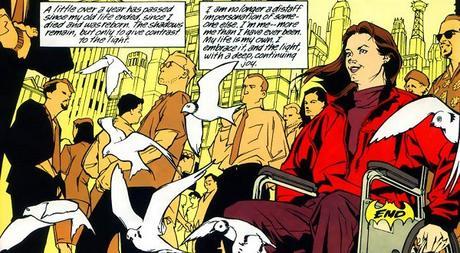
The Killing Joke is still considered one of the great Batman stories, and if you strip away the legacy of the book then you can certainly see why. Moore and Bolland did some excellent work with this comic, Bolland’s art in particular shines in the remastered edition as he’s recoloured it himself. Moore’s story was still a bit weak, at least for Moore. The relationship between Batman and the Joker is well presented here, but the ending is a little lacking unless it is about Batman killing the Joker. But that is a story point so vaguely done most people who read the book don’t consider that ending a possibility. There is even an animated movie adapting it coming out July 2016, and I’d be surprised if the ending even vaguely hints at the possibility of Batman killing the Joker. But there’s a chance it might do something to help Barbara since there’s supposed to be fifteen extra minutes added in since the story is only 45 pages and the movies are 110 minutes long. So maybe she’ll get to be more of a character, but more than likely she’ll still be lacking any agency since they won’t stray too far from the original.
Much like with Dark Knight Returns this seems like a Batman story DC can’t seem to let go of. Maybe it’s time that they did, to stop trying to reference the past and to instead forge something new like Moore did.
